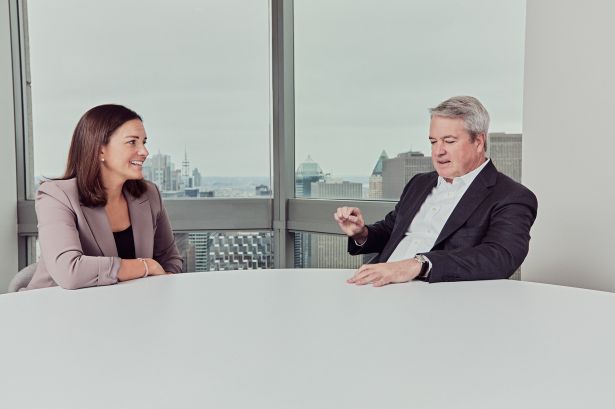JP Morgan’s Michelle Herrick and Brian Baker On CRE Lending in 2025
And what the market holds for 2026
By Brian Pascus November 4, 2025 7:00 am
reprints
While all the recent headlines about J.P. Morgan Chase are fixated on the opening of the firm’s new 2.5 million-square-foot skyscraper in Midtown Manhattan, a sense of exclusivity took place during an interview CO held with two titans of J.P. Morgan Chase’s lending operations.
Michelle Herrick, head of commercial real estate at J.P. Morgan Chase, and Brian Baker, global head of commercial mortgages at J.P. Morgan Securities, sat down Oct. 21 to discuss the market surprises of 2025, the enormous growth of the data center space, affordable housing, and why each lender is optimistic about the months ahead.
It’s been an interesting 10 months for the capital markets, and Baker kicked off the conversation by highlighting the contrasts between the beginning of the year versus the current state of play as the market enters the home stretch of 2025. He spoke of the valuation issues, higher interest rates, and the lingering, Advil-resistant hangover around office assets at the start of the year, and how each of those residual complexities have been flipped on its head — much to the benefit of J.P. Morgan’s real estate operations.
“And as we progress through the year, I think we sit in a very competitive, very healthy, very active lending environment, really across all asset classes,” he said.
Herrick agreed with Baker’s assessment, emphasizing that the firm has stayed active amid several different market disruptions the past five and a half years, namely the COVID-19 pandemic, the regional banking crisis, and the quantitative tightening from the Federal Reserve that helped increase both short-term and long-term interest rates.
“It’s been nice to see, in 2025, a return to transaction volumes, proactive fundraising,” she said. “And we’re starting to see the dry powder that had been sitting there in some of the closed-end funds get activated.”
Herrick added that in debt markets today, “all capital sources are firing,” and borrowers across the lending spectrum are able to refinance or secure all types of debt capital for either acquisitions or construction in a much easier fashion than had been the case in recent years.
“A lot of our clients that had very patient capital are finding compelling opportunities to trade back in the market this year,” she said. “In terms of debt needs for those opportunities, the choice is yours as the borrower — it’s very attractive, and is very much a shift, relative to some of those periods of volatility of the last five years.”
Baker added that senior management at J.P. Morgan provided his teams with more resources to grow its lending business, under the mandate to keep “a very broad mindset” around different opportunities and property types.
“The sort of culture and mindset is: When clients have a lending need, or they have a problem, or they need a solution, it’s our job to figure it out,” he said. “There’s no property types that are off any list.”
Data center nation
One topic that neither Herrick nor Baker was shy to share their opinions on was data center investment, with J.P. Morgan Chase ahead of the game when it comes to CRE lending into an asset class that will power the growth of artificial intelligence and cloud computing.
Baker admitted that amid all the changes seen in capital markets across 2025, the firm’s interest in data centers “exploded in a gargantuan way.”
Herrick noted that, when it comes to increasing investments and lending into the data center sector, “there is clearly a very compelling case across the market,” mainly because data centers are expected to “fully change the way all of us interact on a day-to-day basis,” she said.
Baker pointed to the firm’s $22 billion loan to build Vantage Data Centers, a new 1,200-acre data center campus in Shackelford County, Texas, a project that is also supported by debt from Mitsubishi UFJ Financial Group and equity from Silver Lake and DigitalBridge. J.P. Morgan has also provided $7 billion in credit to OpenAI to build a new data center campus in Abilene, Texas.
“When we refer to data centers, we’re not sure if it’s our day job or our night job, but we definitely have two full-time jobs right now in terms of the explosion in that space,” said Baker, before admitting: “The amount of capital that’s needed, it’s the sort of numbers that people, when they hear them, they kind of say, ‘Can that be real?’”

Baker emphasized that J.P. Morgan anticipates becoming a leader in the space, and that the firm has dedicated “a tremendous amount of resources” into better understanding data center production and development, to the point that it has integrated its commercial banking teams with its specialized technology bankers, as well as its energy teams, namely to understand the intricacies of electricity, power, clean energy, and gaining access to power lines while ensuring compliance with any sort of emissions-related issues when it comes to data center development.
“Basically, early on, we said we have to get smart about it, so we pulled in a bunch of folks that live day-to-day in energy, the delivery of energy and energy contracts, and that’s really helped augment what we’re doing to make us smarter about it,” said Baker.
Competitor or client?
It wasn’t difficult for the question of debt funds and private credit to make an appearance during the discussion, as the explosion of private credit into a $1.7 trillion industry in 2025 has garnered the attention of all players across the lending space.
Herrick pointed out that debt funds and private credit firms are often clients and partners via loan-on-loan financing clients for J.P. Morgan Chase, rather than being merely competitors for a wide spectrum of CRE loans, in turn creating a complex network of relationships the firm needs to navigate.
“The reality is that these are important clients of ours in a lot of ways, but as competitors they are fierce, right?” said Herrick. “It’s a challenge to us to make sure we’re as sharp as possible in everything that we do.”
Herrick added that “there’s potentially a different standard that could emerge in the market” due to the explosion of unregulated private credit, but she tempered this view by adding that additional sources of capital into capital markets are never a bad thing, especially after the pullback in commercial lending in recent years.
“It’s a new source and it’s somewhat untested. We haven’t seen it go through — in this size that it currently exists today — a major recession,” she said. “But we have partnerships there, and we have sharpened our credit product offering to float around all capital sources.”
Baker largely agreed with this, but added that the competition and coordination with private credit occurs on “a case-by-case basis,” with the firm considering strong senior relationships, active dialogue, and mutual respect as the prime themes when it sizes up whether to interact with private credit firms as either “large competitors or large clients.”
“Is there a good dialogue? Do we both respect what the other firm is doing? Can we help each other?” wondered Baker as he listed some of the questions the firm’s credit committee asks before each deal. “But at the same time, our loyalty and our job is to our shareholders and our clients, and we always have to kind of keep that in the back of our mind.”
Baker added that even amid the growth of private credit, J.P. Morgan Chase remains “fiercely protective of our market share and our clients,” and that while he hopes, in the event of any head-to-head competition with private credit, the firm will prevail because “we’re offering a better solution or a better product or we’re a better total relationship.”
Herrick laughed and added, “With the depth of J.P. Morgan’s products, we’re pretty comfortable going head-to-head with all of our competition,” before noting that it’s all “friendly competition.”
Looking ahead
The conversation between these two lending heavyweights then turned to specific sectors of the market where each person is an expert.
Herrick touched on the affordable housing marketplace, which is likely to be impacted by the Trump administration’s proposed 44 percent cut to the Department of Housing and Urban Development, a federal agency that oversees affordable housing, homelessness, and community development programs. The cuts could open the door for more private sector solutions for affordable housing in America.
“We intend to play a large role, and we’re well positioned to do so,” said Herrick, who oversaw J.P. Morgan’s $6 billion of credit and equity investments in 2024 that contributed to either the creation or retention of 45,000 affordable units.
“[Affordable housing] certainly can always use more capital, right?” she added. “These are incredibly complex capital stacks, in the equity and the debt, it takes all boats rowing in the same direction to drive as much impact as possible on a clear need created by a shortage that is now hitting most Americans.”
Of the $42.4 billion in originations that J.P. Morgan Chase made in 2024, $17.5 billion went into the multifamily space, and $5.4 billion of that money provided capital for rent-restricted housing, making the firm one of the top multifamily lenders in the entire country. Moreover, Herrick emphasized that J.P. Morgan’s commercial real estate agency and institutional capital team secured its Freddie Mac Targeted Affordable Housing Optigo lender license in September.
“We’re very excited with what that allows us to do both to support the overall housing market but also support a lot of our clients that are active in that space,” she said.
Finally, Baker spoke of his bread-and-butter, commercial mortgage-backed securities (CMBS), an area where J.P. Morgan Chase has been active in 2025.
The firm has been a CMBS lender on several large transactions, notably a $2.85 billion CMBS refinancing of The Spiral, a 66-story office tower that opened in 2023 in Manhattan’s Hudson Yards, and a $330 million CMBS debt package to refinance 300 Park Avenue in Manhattan, both deals for developer and owner Tishman Speyer.
“We’re firing on all cylinders, as we go into 2026,” said Baker, who listed tighter credit spreads and lower interest rates on the short end and the long end of the curve as reasons for increased optimism around CMBS issuance. He said the firm expects to see a CMBS market with more than $150 billion in originations when 2025 is all said and done.
“Borrowing rates for clients are coming down dramatically, and with that backdrop, we are very optimistic on an uptick in activity,” he added.
Herrick took an optimistic tone as well, to close the conversation. She said the year began with lenders facing a $2 trillion “wall of maturities,” but given the improvement in capital markets conditions, the refinancings and workouts of many of those loans is now a much easier proposition than originally anticipated.
“It looks like that will be more of a slide than a wall, so it would be a little bit more fun than painful,” she told Baker.
Brian Pascus can be reached at bpascus@commercialobserver.com.



